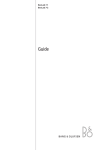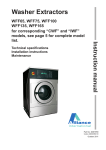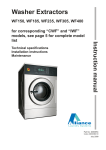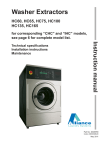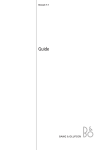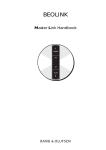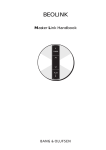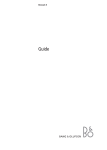Download Bang & Olufsen BeoLab 7-4 Specifications
Transcript
BeoLab 7-4 Guide CAUTION RISK OF ELECTRIC SHOCK DO NOT OPEN CAUTION: To reduce the risk of electric shock, do not remove cover (or back). No User-serviceable parts inside. Refer servicing to qualified service personnel. WARNING: To reduce the risk of fire or electric shock, do not expose this appliance to rain or moisture. Do not expose this equipment to dripping or splashing and ensure that no objects filled with liquids, such as vases, are placed on the equipment. To completely disconnect this equipment from the AC Mains, disconnect the power supply cord plug from the AC receptacle. The lightning flash with arrowhead symbol within an equilateral triangle, is intended to alert the user to the presence of uninsulated “dangerous voltage” within the product’s enclosure that may be of sufficient magnitude to constitute a risk of electric shock to persons. Cautions! – Make sure that the loudspeaker is placed and connected in accordance with the instructions in this Guide. To prevent injury, use Bang & Olufsen approved stands and wall brackets only! – The loudspeaker can only be switched off completely by disconnecting it from the wall socket. – Do not attempt to open the loudspeaker. Leave such operations to qualified service personnel! – The loudspeaker is designed for indoor use in dry, domestic environments only, and for use within a temperature range of 10–40º C (50–105º F). – Do not place any items on the loudspeaker. – Do not lift the loudspeaker by gripping the acoustic lens. – Prolonged listening at high volume levels may cause hearing damage! The exclamation point within an equilateral triangle is intended to alert the user to the presence of important operating and maintenance (servicing) instructions in the literature accompanying the product. Acoustic Lens Technology – manufactured under license from Sausalito Audio Works. Daily use When you have finished setting up the loudspeaker as described on the following pages, connect the entire system to the mains. Loudspeaker protection The loudspeaker is equipped with a thermal protection system which prevents damage from overheating. If an error occurs – or the speaker units become overheated – the system automatically switches the loudspeaker to standby. To restore the sound: > Disconnect the loudspeaker from the mains. > Allow the system time to reset or cool down (approximately 3–5 minutes). > Reconnect the loudspeaker to the mains. Should the problem persist, contact your Bang & Olufsen retailer. 3 Cleaning the loudspeaker Clean dusty surfaces using a dry, soft cloth. If necessary, remove grease stains or persistent dirt with a lintfree, firmly wrung cloth, dipped in a solution of water containing only a few drops of mild detergent, such as washing-up liquid. Never use a vacuum cleaner to clean the exposed speaker membrane in the acoustic lens. However, the loudspeaker front grill may be cleaned with a vacuum cleaner with a soft brush nozzle, and set to the lowest level. Never use alcohol or other solvents to clean any parts of the loudspeaker! Switching on and off When you switch on your Bang & Olufsen system, the loudspeaker switches on simultaneously, and when you switch the system off again the loudspeaker also switches to standby. ! Caution: Do not touch the exposed speaker membrane in the acoustic lens! Handle the loudspeaker front grill with great care. Dents and scratches are not covered by the guarantee! Set up the loudspeaker 4 We recommend that you follow this procedure: – Disconnect your Bang & Olufsen system from the mains. – Mount the loudspeaker to the Bang & Olufsen stand or wall bracket as explained on the next page. – Connect the loudspeaker as explained in ‘Cable connections’ (pp. 6–7). – Set the POSITION switch to the correct setting. This is explained in ‘Adapt the loudspeaker to your room’ (pp. 8–9). – Connect the entire system to the mains again. ‘Type 1 bracket’ ‘Type 2 bracket’ BeoLab 7-4 brackets: The loudspeaker must be fastened to one of the brackets shown here, and on a suitable Bang & Olufsen stand or wall bracket. Use the ‘type 1 bracket’ when the loudspeaker will be fastened to one of the ‘single-column’ Bang & Olufsen stands or wall brackets. Use the ‘type 2 bracket’ when the loudspeaker will be fastened to one of the ‘double-column’ Bang & Olufsen stands. Placement: The loudspeaker must be placed centred below the screen. Always place the loudspeaker in an upright position! If the loudspeaker is mounted on the wall, for example in a BeoVision 4 setup, we recommend that you place the loudspeaker 5–15 cm (~ 2–6") below the screen, and no more than 98 cm (~ 35") above the floor. 5 Here is shown how to fasten the loudspeaker with a ‘type 1 bracket’ to a Bang & Olufsen ‘single-column’ stand (or wall bracket). Use the same procedure if you wish to fasten the loudspeaker to a Bang & Olufsen ‘double-column’ Stand – with a ‘type 2 bracket’. a Remove the small cover (if any) on the stand. Press the cover as shown, and it will come loose. b Fasten the bracket to the stand or wall bracket. Use the two longest screws (M5 × 25 mm) – four screws for a ‘type 2 bracket’. c Fasten the loudspeaker to the bracket. Use the short screw (M5 × 8 mm). However, do not fully tighten it until you have made the adjustments mentioned to the right (d). a c c b Adjustments: Use the two screws (d) to align the loudspeaker with the stand or wall bracket. Then position the loudspeaker so that the side is vertical, and finally tighten the screw (c). c d d d c Cable connections 6 The loudspeaker is primarily intended to be used in a surround sound setup with BeoVision 7*. It may, however, be used with other Bang & Olufsen systems as well – for example in a BeoVision 4 surround sound setup. Mains connection to BeoVision 7 POWER LINK socket POSITION switch If used in a setup not including BeoVision 7, you will require a mains cord and a Power Link cable. These cables are available as optional accessories from your Bang & Olufsen retailer. The socket panel is located on the rear of the loudspeaker. Mains connections The loudspeaker has two sockets concerning mains supply. The socket marked ~ is for mains supply input (connection from the wall outlet), and the other is a mains supply output to BeoVision 7 (this socket is not available on loudspeakers intended for the USmarket). Note: The mains cord from the wall outlet must be fastened to the cable clamp on the loudspeaker – as shown on the next page. *NOTE! BeoVision 7 and its accessories are not available on all markets. Cable clamp POSITION switch This switch has two settings: F (Free-standing position) and W (Wall position). Which setting to use is explained in ‘Adapt the loudspeaker to your room’ (pp. 8–9). POWER LINK socket Use this socket to connect the loudspeaker to one of the Power Link sockets on the Bang & Olufsen system – see the next page. 7 Connection to BeoVision 7 … Connect the loudspeaker to one of the Power Link sockets on the left BeoVision 7 socket panel. BeoVision 7 BeoLab 7-4 For further information about the BeoVision 7 socket panels, refer to the Guides enclosed with the product. Cable clamp: For safety reasons, the mains cord from the wall outlet must be secured to the loudspeaker. To do so, tug the cord behind the clamp. The two mains cords and the Power Link cable are enclosed with BeoVision 7. Connection to other Bang & Olufsen systems … Use a Power Link cable of the correct type to connect the loudspeaker to a Power Link socket on the Bang & Olufsen system. For further information, refer to the Guide enclosed with the Bang & Olufsen system. Power Link Mk 3 Power Link cable: Do not use a cable of the older type, as this will cause noise, and therefore not give optimum sound quality! The new type has a triangular mark on the plug. Adapt the loudspeaker to your room 8 When a loudspeaker is placed in a corner or close to a wall, the bass level is boosted compared to the bass level from a loudspeaker placed in a more free-standing position. To remove this excessive bass boost, use the POSITION switch to ensure that the bass level suits the placement of the loudspeaker. The appropriate switch setting depends on the distance from the loudspeaker to the walls and corners of the room. The POSITION switch • F (Free-standing position) Use this setting if the loudspeaker is placed so that the front grill is more than 50 cm (20") from the rear wall, for example on one of the stands. • W (Wall position) Use this setting if the loudspeaker is placed so that the front grill is less than 50 cm (20") from the rear wall. Always use this setting if the loudspeaker is placed on any of the wall brackets, but also when placed on one of the stands – close to the rear wall. F W 9 The POSITION switch is located on the loudspeaker socket panel. F W How to measure: The distance is measured as shown here – the loudspeaker seen from above. 10 To get access to the approval labels, remove the loudspeaker front grill: Push the front grill downwards until stop (~ 10 cm/4"). The front grill can now be removed. Note: When attaching the front grill again, first insert the centre peg into the bottom end of the groove (a), and move the front grill upwards. Make sure that all six ‘attach-points’ engage fully with the corresponding brackets on the loudspeaker (b), so that the front grill is properly seated. b b b b b b a For the Canadian market only! This class B digital apparatus meets all requirements of the Canadian Interference-Causing Equipment Regulations. This product fulfils the conditions stated in the EEU directives 89/336 and 73/23. Technical specifications, features and the use thereof are subject to change without notice! 3509130 0508 For the US-market only! NOTE: This equipment has been tested and found to comply with the limits for a class B digital device, pursuant to part 15 of the FCC Rules. These limits are designed to provide reasonable protection against harmful interference in a residential installation. This equipment generates, uses and can radiate radio frequency energy and, if not installed and used in accordance with the instructions, may cause harmful interference to radio communications. However, there is no guarantee that interference will not occur in a particular installation. If this equipment does cause harmful interference to radio or television reception, which can be determined by turning the equipment off and on, the user is encouraged to try to correct the interference by one or more of the following measures: – Reorient or relocate the receiving antenna. – Increase the separation between the equipment and receiver. – Connect the equipment into an outlet on a circuit different from that to which the receiver is connected. – Consult the retailer or an experienced radio/TV technician for help. Printed in Denmark by Bogtrykkergården a-s, Struer www.bang-olufsen.com












